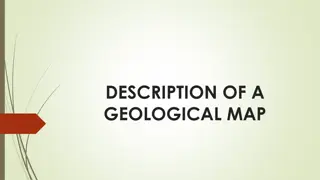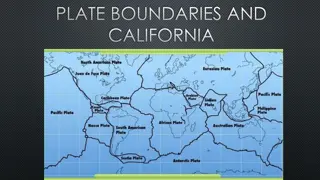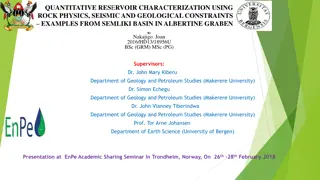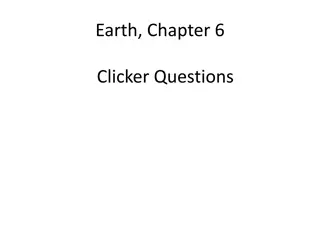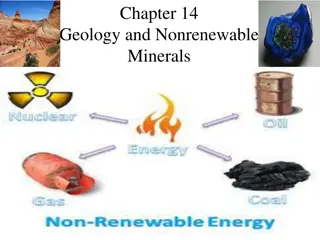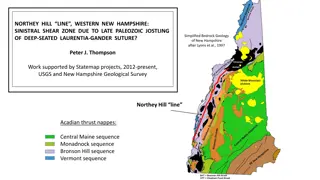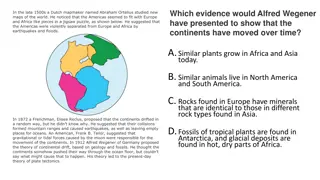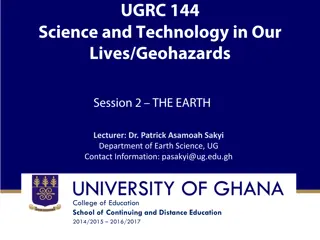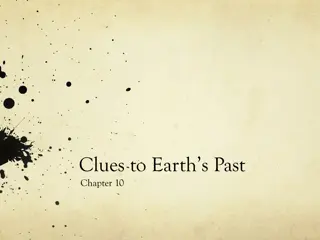Understanding the Geological Time Scale and Earth's Evolution
Studying the geological time scale is crucial for comprehending Earth's history, evolution of life, and significant events that shaped our planet. Evidences like field observations, fossil records, and radioactive dating contribute to constructing this vast timeline. Major occurrences such as mass extinctions, continental drift, and glaciations are key considerations. The scale spans billions of years, showcasing remarkable changes in Earth's physical systems over time, crucial for understanding the evolution of our planet.
Download Presentation

Please find below an Image/Link to download the presentation.
The content on the website is provided AS IS for your information and personal use only. It may not be sold, licensed, or shared on other websites without obtaining consent from the author. Download presentation by click this link. If you encounter any issues during the download, it is possible that the publisher has removed the file from their server.
E N D
Presentation Transcript
GEOLOGICAL TIME SCALE Dr. H Debbarma
Introduction: While studying the physical geography of the earth, it is necessary to know THE GEOLOGICAL TIME SCALE of the earth. The study of the geological time scale is necessary to every student of earth and other sciences. The development of the Earth has taken place over a period of billions of years. The evolution of life on earth is also a part of the Earth s very long history. The age of the earth is also related to the age of the Solar System and the Milky Way Galaxy. From the BigBang, till today , the time frame of the Earth s evolution is very extensive. The periods of remarkable development in the evolution of life, evolution of continents, evolution of ocean basins and their constituents are represented in the form of eras, periods, epochs and ages. The Geologic time is very vast and wide
The Geological Time Scale was constructed using the evidences collected from a) Field observations b) Fossil records c) Stratigraphic correlations d) Radioactive dating e) Palaeomagnetic orientations f) Orbital revolution of the Earth and g) The rotation of the earth.
Several major incidences have happened in the history of the earth. Some of the major events like- a) mass extinctions, b) appearance of new species or genera of life, c) mountain-building movements d) drifting of continents e) spreading of ocean floors f) widespread glaciations g) dominance of certain species h) massive migration of life between land and water are all considered while accounting the geologic time scale.
The changes that occurred throughout the history of the earth stand in marked contrast to the orderly and uniform operation of natural systems. Early history differs in character from late history in the time scale used. Whereas the early history is described in billion-year units of time, the late geological time is described in million-year units of time. The recent time is described in 1000 s of year units. Experts attempted to reconstruct the Schedule of events of profound change in various aspects of the earth s physical systems. Understanding of the geologic time scale is a basic necessity while studying the geography of the earth
THE GEOLOGIC TIME SCALE The Hot original matter of the Universe is the starting point of the time scale. About 15.0 billion years ago, the hot Universe matter, with unimaginable temperature, was believed to have been in existence. We know that the Universe can not be younger than its products. It must be older than the individual galaxies, older than the earth and older than all the chemical elements. Evidences indicate that an important event occurred about 10 to 12 billion years ago, that this mass got expanded and exploded.
Due to this, the galaxies got separated from this mass and in a similar process, the stars and their planets were separated. If the Universe just keeps on expanding, then the galaxies will get farther and farther apart until each one is alone in space. A rough calculation shows that this would have been about 10 to 12 billion years ago. The Big-Bang theory also states this globe of energy and its sequential release of galaxies, very clearly. Formation of Galaxies, Stars and Planets happened from this hot universe. About 10 billion years ago the first generation galaxies started to spiral around and got released one after the other.
The Milky Way Galaxy got released at about 6 billion years ago. From this mass, the Sun and the other members of the Solar System got originated at about 5 billion ago. In an accurate estimate, it if found, that the Sun and its Planets were born around 4.56 billion years ago. Millennium, century and decade are the references made to denote the periods used in these time units. In addition, the divisions in the time scale were made into the following units: a) EON is the mega unit comprising a duration of half a billion years (or) more time b) ERA is used to refer the duration of several hundred millions of years c) PERIOD is used to cover hundreds of millions of years d) EPOCH is used to denote the duration of Tens of Millions of years and e) AGE is used to cover a duration of Millions of years in the earth s history
The Geologic Time Scale of the earths is divided into two major eons as: a) Phanerozoic eon b) Cryptozoic eon. The term phanerozoic was derived from the Greek word Phoneros meaning Visible , and Zoo means life. The term Phanerozoic was used to refer the eon of visible life on earth. The term azoic was used to denote the eon of no life on earth. The term CRYPTOZOIC was derived from the Greek word Crypto means Hidden and Zoo means life. Cryptozoic eon refers to the eon of hidden life.
These two Eons are divided into various ERAS. The geologic time of the earth is divided into five major eras as: 1) CENOZOIC ERA -(Greek: Kaines Recent, Zoo- life)- 65 mya to the present 2) MESOZOIC ERA- (Greek: Mesos Middle, Zoo-life) Age of Reptiles/Ammonoids- 245 66.4 mya 3) PALAEOZOIC ERA-(Greek: Paleos ancient, Zoo-life)- 540 245 mya 4) PRECAMBRIAN ERA (OR PROTEROZOIC ERA)- Greek: Protero Primitive, Zoo-life) 4500 mya 540 mya. 5) ARCHAEAN ERA
The duration of PRECAMBRIAN EON refers to the Span of time between 4500 mya and 540 mya. It is further divided into two eras as: 1) PROTEROZOIC ERA - from 2500 mya to 540 mya 2) ARCHAEAN ERA -from 4500 mya to 2500 mya.
https://www.google.com/imgres?imgurl=https%3A%2F%2Fwww.pmfias.com%2Fwp-content%2Fuploads%2F2019%2F09%2Fthe-geological-time-https://www.google.com/imgres?imgurl=https%3A%2F%2Fwww.pmfias.com%2Fwp-content%2Fuploads%2F2019%2F09%2Fthe-geological-time- scale.png&imgrefurl=https%3A%2F%2Fwww.pmfias.com%2Fgeological-time-scale-hadean-archean-proterozoic- phanerozoic%2F&tbnid=VVoS3cmskWceTM&vet=12ahUKEwisj4LZypvxAhW8m0sFHUPmBUIQMygIegUIARDSAQ..i&docid=21PtVSiUelVlxM&w=602&h=615&q=geological%20 time%20scale%20pdf&ved=2ahUKEwisj4LZypvxAhW8m0sFHUPmBUIQMygIegUIARDSAQ
PRECAMBRIAN ERA The Precambrian era is the oldest era of the earth. The period between the formation of Earth around 4600 Mya to the beginning of Cambrain period (about 542 Mya ago) is named as the Precambrian Era. It accounts for 88% of the total geologic time. Very little is known about the Earth s history during this period. The fossil record of Precambrian period is very poor. The fossils present like stromatolites are of limited biostratigraphic use. Details of plate motions and other tectonic functions are hazily known in the Precambrian.
The notable observations of Precambrian period are: 1. First appearance of life on earth 2. Tectonic Plates were present and began moving 3. Atmosphere became enriched in oxygen 4. Dry and cold climate to warm and moist conditions prevailed on the earth This is the earliest of all the geologic ages. It is further divided into Proterozoic Era (2500-540 Mya) and Archean Era (3960-2500 Mya).
The age of the earth is probably about 4500 mya. The Archean Era: The Archean Era is the oldest era of the earth between 3960 mya and 2500 Mya. The significant observations of this period are: Extensive mountain-building, Formation of banded iron ores and Greenstone belts Existence of shallow seas Accumulation of free oxygen, and Origin of life, especially the prokaryotes, bacteria and blue- green algae.
The Proterozoic Era: The Proterozoic Era (2500-540 Mya) is the second era after Archaen era. The significant observations of this period are: Dry and Cold climate Warm and moist conditions Origin of Eukaryotic cells and multicellular life Occurrence of earliest known fossils including of soft-bodied marine invertebrates, Origin of Sponges, Cnidarians and Annelids. (Sea anemones) (segmented flatworms)
PALAEOZOIC ERA: The duration of PALAEOZOIC ERA is the time of Ancient life. This is the second major era of earth s history. It is the age of Invertebrates. This era has the Span of time between 540 mya and 245 mya. It is further divided into six periods as: 1) Permian - 286 - 245 mya 2) Carboniferous - 360 - 286 mya 3) Devonian - 408 - 360 mya (Age of fish) 4) Silurian - 438 - 408 mya 5) Ordovician - 505 - 438 mya Age of Graptolites 6) Cambrian - 540 - 505 mya (Age of trilobites)
Cambrian Period: The Cambrian Period is spread between 540 and 505 Mya. This the period of abundant life on Earth, after the Proterozoic.
are: The significant observations of Cambrian period Prevalence of Mild climate Extensive seas, spilling over continents Shelled Marine invertebrates Explosive growth of Eukaryotic organisms Swimming, floating, crawling, clinging and burrowing sea animals Appearance of Trilobites, Brachiopods, Gastropods, radiolarians, sponges, echinoderms, starfish, sea cucumbers, jelly fish, worms and water scorpions Existence of plants was observed only as algae. Absence of land plants. Prosperity of life in the oceans than lands. During this period the continents had a soil crust and were resembling like deserts.
The Ordovician period: The Cambrian Period is followed by the Ordovician period. It has the duration between 505 and 438 Mya. The significant observations of the Ordovician period are: Mild climate-Adaptive Radiation (Ordovician radiation) Shallow seas retreating from land and spreading back All plants and animals still restricted to water First vertebrates originated as jawless fishes Invertebrates dominated
Crustaceans, trilobites, graptolites, brachiopods, bryozoans, echinoderms, corals, mollusks, and cephalopods dominated the water masses. First fungi originated Invasions of land by plants started Sea levels were high during Ordovician First known marine transgressions occurred during this period. Southern Continents were collected into a single land mass. It was named as Gondwana Land. Major mountain-building activity happened during this period.
The Silurian Period: The Ordovician period is followed by the Silurian Period. It is spread between 438 and 408 Mya. The significant observations of the Silurian period are: Mild climate, stable and warm temperature Continents were generally flat and flooded Notable Mountain building occurred in Europe Rise of fishes and reef building corals Abundance of shell-forming sea animals Dominance of Sea lilies, eurypterids and land scorpions Invasion of land by arthropods Origin of the earliest Vascular Plants on earth Modern group of Algae and Fungi got evolved. 60% of Marine species were wiped out at the base of the Silurian period. First period to see macrofossils of extensive terrestrial biota.
The Devonian Period: The Silurian period is followed by the Devonian Period. It is spread between 408 and 360 Mya. The significant observations of the Devonian period are: Violent volcanic eruptions and crustal movements Folding, mountain-building activities prevailed Climate became drier Sea covered most of the land Age of fishes, sharks and rays Fishes move into the open seas. Lunged fishes, amphibians appeared in Devonian. Mollusks were abundant Extinction of primitive vascular plants happened Origin of modern Vascular plants with true leaves, roots and stems Earth appeared to look green Some plants started to produce seeds rather than spores
The Carboniferous Period: The Devonian Period is followed by the carboniferous period. It is spread between 360 and 286 mya. The significant observations of the Carboniferous period are: It is known for its coal deposits, lime stones and Grit stones Hercynian orogenic movements Abundant life on land and water. Large Primitive Trees, First land vertebrates
Sea Invertebrates: Prevalence of Foraminifers, Bryozoans, Brachiopods, Cephalopods, Blastoids, Crinoids and Corals. Brachiopods are the zone fossils of Carboniferous period. Lamellibranchs and winged insects were important fauna. Swamp forests with ferns were existing. Lepidodendron and Sigillaria were prominent flora First Reptiles laid eggs with shells in this period. Highest ever atmospheric oxygen levels seen on earth was in this period.
The Permian Period: The carboniferous period is followed by the last period of this era called Permian period. It is spread between 286 and 245 mya. The significant observations of the Permian period are: World-wide continental uplift and orogenic movements. Widespread aridity on one side and Glaciation at the other side. Extinction of Palaezoic Plants and invertebrates (251 Mya). Reduction in all types of life. Almost 95% of life on the earth became extinct.
Primitive reptiles dominated in places. Extinction of all Trilobites, Graptolites and Blastoids. Beetles and flies got evolved. Marine life flourished in warm shallow reefs. Abundance of Spiriferid brachiopods, bivalves, foraminifers and ammonoids. Cone-bearing Gymnosperms (the first true seed plants) and the first true mosses appeared. Landmasses unite into the super continent Pangaea, creating the Appalachians. This period records the end of Permo-Carboniferous glaciations.
4. MESOZOIC ERA: The duration of MESOZOIC ERA is the time of Middle life in the history of the earth. This is the Age of reptiles. This era has the span of time between 245 mya and 66.4 mya. It is further divided into three periods as: 1) Cretaceous- 144 - 66.4 mya 2) Jurassic - 208 - 144 mya 3) Triassic - 245 - 208 mya.
The Triassic Period: The Triassic period is the first period of the Mesozoic era. It is spread between 245 and 208 mya. The significant observations of this period are: Continent emergent Seas marginal Climate arid. Occurrence of Terrestrial deposition. Formation of Salt, Gypsum and red beds Dominance of Archosaurs on land as dinosaurs, ichthyosaurs, nothosaurs in oceans and pterosaurs in the air.
Appearance of Primitive Mammals Domination of Reptiles and Cycads. Reduction of Marine Invertebrates. First mammals and crocodilian appeared. Dicroidium flora were common on land Extreme abundance of ceratitic ammonoids were seen. Modern Corals appeared. Orogenic Movements prevailed in some parts. Pangaea still in existence. Altering global climate and ocean circulation happened. Appearance of modern conifers, cycadeoids, first turtles, lizards, mammals and dinosaurs.
The Jurassic Period: The world s most famous period is the Jurassic period.The Dominance of Dinosaurs in Jurassic got registered in every mind of the human life due to global media coverage.It is spread between 208 and 44 Mya. The significant observations of the Jurassic period are: Atmospheric CO2 levels 4-5 times more than the present day levels (1200-1500 ppmv). Many types of Dinosaurs-Sauropods, Carnosaurs and steepsaurs dominated. Great plant eating dinosaurs were in existance.
Lush growth of ferns and palm-like cycads, Gymnosperms also have grown much. Oceans were with full of fish, squids and coiled ammonites. Appearance of the first frogs, salamanders, crocodiles, flying reptiles and birds were noticed. The formation of oilfields of North Sea happened. The First birds and lizards appeared. Mammals were common. Bivalves, Belemnites and Anmonites were abundant. Sea urchins were common along with crinoids, starfish, sponges, terebratulid, rhynchonellid brachiopods. Breakup of Pangaea into Gondwana and Laurasia happened during this period only.
The Cretaceous Period: The cretaceous period is a notable period in geologic history. It is spread between 144 and 66.4 Mya. ) The significant observations of the Cretaceous period are: This is the last period of the age of Dinosaurs. First primates, angiosperms appeared. World continent Pangaea begins. Atmospheric Co2 close to present day levels.
Modern flowering plants proliferated along with new types of insects. Ammonites, belemnites, bivalves, echinoids and sponges were all common. Many new types of dinosaurs and crocodilians appeared on land. Modern sharks appeared in the sea. Primitive birds appeared (toothed birds and flying reptiles) Breakup of Gondwana and beginning of Rocky Mountains. Widespread epicontinental Seas. Extensive chalk deposits. Marine Pelecypods were very abundant.
CENOZOIC ERA: The duration of CENOZOIC ERA is the time of Recent life. This is the age of mammals. This era has the Span of time from 65 mya ago to the present day. It is further divided into two major eras as: 1) Quaternary Era (Age of man) and 2) 2) Tertiary Era (Age of mammals). The Tertiary era includes the periods: 1. Pliocene 05-02 Mya 2. Miocene 25-5 Mya 3. Oligocene 38-25 Mya 4. Eocene 55-38 Mya 5. Palaeocene 65-55 Mya. The Quaternary era includes the periods: 1. Holocene 10000 years to the present 2. Pleistocene 1.6-0.01 Mya
Palaeocene Period (65-55 Mya): The significant observations of this period are: Climate Tropical Modern plants appear. Mammals diversity into a number of primitive lineages following the extinction of the dinosaurs. First large mammals. Alpine orogeny. Himalayan orogeny (55 ma. 52 and 48 mya).
Eocene Period (55-38 Mya): The significant observations of this period are: Sea Marginal Extensive terrestrial sedimentation Reglaciation in South Pole Dawn of mammalian dominance. Subordinate position for reptiles. Moderate, cooling climate Archaic mammals flourished Primitive whales diversity was seen. First grasses appeared.
Oligocene Period (38-25 Mya): The significant observations of this period are: Warm but cooling climate Rapid evolution and diversification of fauna especially the mammals and modern flowering plants. Early ancestral elephants. Carnovires and ungulates become well- established.
Miocene Period (25-5 Mya): The significant observations of this period are: Moderate Icehouse climate. Extensive glaciation in Southern Hemisphere. Orogeny in Northern Hemisphere Modern mammal and bird families become recognizable. Horses and Mastodons diverse. First Apes appeared. Whales, Apes and grazing mammals dominated. Widespread volcanism and basalt flows were seen. Notable advances in the horses and elephant families. Spread of grasslands as forests contracted.
Pliocene Period (05-02 Mya): The significant observations of this period are: Worldwide elevation continues. Continental uplift and mt building. Ice Age begins. Seas restricted. Cool and dry climate. Many of the existing generation of mammals and recent mollusks appear. Homo habilis appears. Horses and Elephants became almost modern in appearance. First known appearance of hominids (human like primates). Large carnivores were dominated.
Pleistocene Period (1.6-0.01 Mya): The significant observations of this period are: The Era of ice ages. Glacial climate. Four great ice advances and retreats. Fluorishing and then extinction of many large mammals. Evolution of modern humans.
Dawn of human stone-age cultures Volcanic eruptions destroy human populations. Cro magnon man First appearance of present species. Neanderthal man Paleolithic culture. Heidelberg man Paleolithic culture. Formation of large scale Deserts Sahara was formed. Planetary spread of Honosapiens over Eurasia. Extinction of many species due to ice ages. Extinction of many large mammals and birds due to humans.
Holocene Period (10000 years to the present): The significant observations of this period are: Rise of human civilization. Major habitat changes and deforestations caused by Introduction of Pests and habitat destruction. Beginning of Agriculture. Humans built cities. Paleolilthic and Nieolithic cultures began around 10000 BC. Copper Age 3500 BC Bronze Age 2500 BC Iron Age (1200 BC) Man used iron implements in 1350 BC Youthful landforms, high relief
of the earth. Time will continue to flow long after the present generation also. To understand the past, we should know the present. To understand the present, we should know the past. The age of the earth is one important aspect in Earth Science studies. Time has been flowing since the beginning
Video: https://www.youtube.com/watch?v=rWp5ZpJA IAE
Reference 1. THE GEOLOGICAL TIME SCALE BY PROF.A. BALASUBRAMANIAN, University of Mysore 2. YouTube source: https://www.youtube.com/watch?v=rWp5ZpJAIAE








